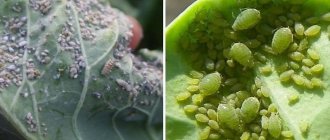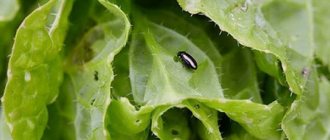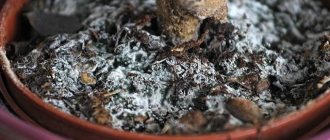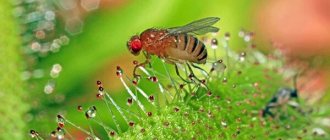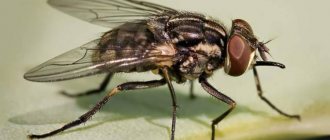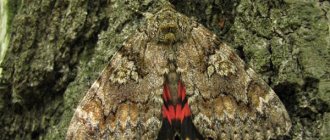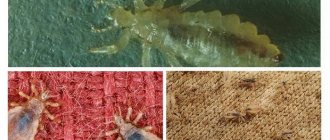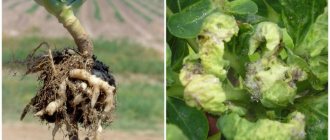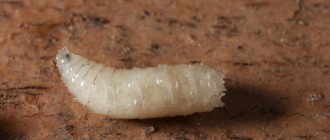Aphids are a dangerous parasite from the order of hemipteran insects that feed on the sap of young plants. This pest often settles on the lower part of cabbage leaves, sucks out the vital juices from them, leading to various diseases and even death of the plant. To prevent such consequences, it is necessary to recognize aphids on cabbage leaves in time and take all measures to combat them.
How to recognize aphids?
Aphids are an invisible but dangerous insect that feeds on plant sap. It can be recognized by the following external characteristics:
- the body is translucent, egg-shaped and short in length - about 2.2-2.5 mm;
- the color of the body is pale green, often appearing gray due to a waxy coating, with brown transverse torn stripes that begin from the first element of the abdomen;
- the head is brown with black eyes and short antennae consisting of 5-6 segments;
- the oral apparatus is small and designed like a proboscis, piercing the integumentary tissues of leaves and drawing out juice from them;
- the tail is conical, dark green in color and without marginal tubercles;
- the legs are brown, as are the cylindrical tubes, which are slightly swollen in the middle and slightly shorter than the tail.
Such pests can often be found on representatives of cruciferous plants, which include not only all types of cabbage, but also the following crops:
- daikon;
- turnip;
- radish;
- radish.
The pest reproduces quickly, since the birth of offspring occurs without fertilization, and one female can lay up to 40-50 larvae. Moreover, about 15-20 generations of this pest change during the season.
In spring and summer, only female insects are born. Males are born in the fall, when females lay eggs on cabbage heads or other cruciferous plants left over for the winter. They winter well if the plants are under snow. In the spring, when the air temperature reaches +11-12°C, the larvae hatch from the eggs, and their life cycle repeats. Females without wings appear after several lines, after about half a month. They do not need males for fertilization, and each of them is capable of producing up to half a hundred larvae.
Cabbage stem weevil (secretive proboscis)
Damages seedlings, young plants and seeds of cabbage, radishes, radishes.
The beetle is black in color and covered with gray scales. Its body length is 3 mm. The rostrum is long, thin, and bent under the chest. The egg is oval, translucent, 0.7 mm long. The larva is whitish, with a yellow head, legless, up to 5 mm long.
The weevil has a one-year generation. Beetles overwinter under plant debris in the soil. In spring they appear on the soil surface in the second half of April. At the end of April - beginning of May, females begin laying eggs. In the midrib of the leaf from below or (less often) in the petiole and stem, the female gnaws out a deep hole with her proboscis and lays an egg in it. The egg stage lasts 4-5 days. The larvae gnaw through the petiole, penetrate the stem, eating away its core, and often descend to the root collar. On large cabbage leaves, the larvae feed in the petiole and do not go into the stem. Damaged leaves dry out, plant growth slows down, and sometimes seedlings die.
On the seeds of cabbage, radish, radish, the larvae damage the leaves and peduncles; the seed yield decreases, the percentage of puny seeds increases. On cauliflower, larvae can burrow from the stems into the head.
The larvae pupate in the surface layer of soil. The hatched beetles feed on the leaves of cruciferous plants, and with the onset of autumn they go to wintering areas.
Control measures. Destruction of weeds on which beetles feed in the spring. Culling and destruction of infected seedlings during planting. Breaking off and destroying heavily damaged leaves before the larvae emerge. Loosening the soil between the rows during the period of pupation of the larvae (June) and deep digging of the soil in the fall after harvesting.
Causes of aphids
In most cases, aphids appear on plants after females accidentally fly into the garden in the spring and lay eggs in the weeds, from which many larvae hatch after winter. This will be the beginning of the insect’s reproduction mechanism.
In addition, ants can spread aphids. They coexist very closely with this pest, since aphids secrete tasty food for them - sweet-tasting honeydew. Thus, ants keep aphid eggs in their anthills even in winter, and in the spring they take them out to the site and spread them over young plants.
If cabbage is infested with aphids, many black ants can often be found on it or near the plantings.
Turnip white (turnip)
A butterfly similar to a cabbage white, but smaller in size. On its front wings there are two black spots for the female, one for the male. The lifestyle and nature of the damage are the same as that of the cabbage white, but the caterpillars of the summer generation can penetrate cabbage heads, contaminating them with excrement and causing rot.
Mustard or mignonette
The wingspan of the butterfly is up to 47 mm. Caterpillars eat cabbage leaves; radish, mignonette. On the seeds of cruciferous plants they damage buds, flowers, and pods.
Control measures. Manual collection of caterpillars and clutches of white butterfly eggs from cabbage. Sowing nectar plants to attract parasitic insects. Release of Trichogramma for the purpose of destroying whitefish eggs. Spraying cabbage against caterpillars with Kinmiks, Fury, against young caterpillars - with lepidocide, bitoxibacillin or infusions (decoctions) of mustard, wormwood, pepper. For better adhesion to infusions and decoctions, add paste (1 cup) or skim milk (0.5 cups) per 10 liters of infusion.
Signs of cabbage damage
Aphids reproduce very quickly, so the sooner they are detected, the better. This can be done by regularly inspecting the cabbage leaves. If the pest has already attacked the cabbage, then this will be indicated by the following signs:
- the leaves become discolored, especially at the top, fade and become more fragile;
- the area between the veins on the leaf blades seems to be decaying and gradually begins to dry out;
- the plant gradually loses its green color, becomes covered with yellow spots and dries out, as it loses chlorophyll and becomes unable to fully carry out photosynthesis;
- cabbage grows poorly because it absorbs nutrients extremely slowly and at the same time quickly loses its vital juices;
- a sticky dirty coating appears on the plant, which is a waste product of parasites;
- with severe damage, the leaves curl into tubes and become deformed, and heads of cabbage do not form.
When inspecting cabbage for the presence of aphids, you need to take into account that the pest initially multiplies on the lower part of the bushes, and over time it spreads to the entire plant.
With severe damage, accumulations of aphids can be seen even with a superficial examination of the cabbage.
Cabbage white (cabbage)
Damages cabbage, radishes, rapeseed Rapeseed is a plant of the Brassica family, an annual herbaceous plant. It is noteworthy that ..., mustard, mignonette, nasturtium.
The wingspan of the butterfly is 55-60 mm. The wings are white. At the top of the fore wings there is a black crescent-shaped spot. The female has two rounded black spots on her forewings. The eggs are yellow, bottle-shaped, with longitudinal ribs. The caterpillar is yellow-green in color, with black spots. There is a yellow stripe along the sides of the caterpillar's body, and a light stripe along the back. The caterpillar has sparse hairs and bristles on its body. Caterpillar length is up to 40 mm.
Cabbage whites develop in 3-4 generations. The pupae overwinter on the trunks of trees, bushes, on fences, and on the walls of buildings. At temperatures of -20°C and below, many wintering pupae die. This explains the low numbers of white moths in the years after a cold winter. Butterflies emerge in April, fly during the day, and feed on nectar on the flowers of various plants.
Butterfly eggs are laid in groups of 15-200 eggs on the underside of leaves of cabbage and other cultivated and weedy cruciferous plants. The egg stage lasts 1-2 weeks. Young caterpillars stick together. They eat the leaf parenchyma from the underside without violating the integrity of the skin (they skeletonize). Damaged leaves turn yellow and dry out. Grown-up caterpillars eat leaves from the edges, often eating leaves entirely, leaving only large veins. The duration of caterpillar development is 2-4 weeks. Caterpillars pupate on fences, walls of buildings, on tree trunks, and on the stems of large weeds. Single caterpillars pupate on cabbage leaves. The number of butterflies of the overwintered generation is usually small, but it increases in subsequent generations.
The number of whitefish during the growing season is reduced by parasites.
Why are aphids dangerous?
The danger of aphids for cabbage lies in the fact that it multiplies quickly, sucks the vital juices from the crop and provokes disruptions in its vital functions, which is why the vegetable develops poorly and dies.
In addition, aphids can infect the plant with various fungal and viral diseases, including:
- mosaic;
- black ring spot;
- necrotic jaundice, etc.
The fact is that aphids are capable of transmitting various diseases from diseased plants to healthy ones. So, if there is a diseased plant in the garden, colonies of insects will quickly spread pathogenic microflora, so other garden plants growing in the neighborhood will also suffer.
Cabbage moth
Damages mainly cabbage, less - other cruciferous vegetables.
The wingspan of the butterfly is 25-26 mm. Its fore wings are dirty yellow, with two oblique brown stripes and a dark spot. The caterpillars are yellowish-green, with a chain of white spots on the back; A yellow stripe runs along the sides of the caterpillar. Caterpillar length is up to 19 mm.
Caterpillars overwinter in the soil. In the second half of May they pupate. Butterflies fly in June - July. The females lay eggs on the underside of leaves of cabbage and other cruciferous plants in small groups. The egg stage lasts 8-10 days. Young caterpillars gnaw holes in the leaves without disturbing the integrity of the skin, while older ones eat through holes in the leaves. A peculiarity of older caterpillars is their tendency to climb inside the budding head of cabbage and damage young leaves there. The fed caterpillars go into the soil to pupate.
Control measures. The main measures in the fight against moth are agrotechnical, ensuring good plant development. Control of weeds on which the moth reproduces. Deep digging of the soil in the fall, changing the usual wintering conditions of the caterpillars. Spraying the plants before setting the head of cabbage with Kinmiks or Fury.
Why is it difficult to control aphids?
Getting rid of aphids is not so easy, since predatory insects refuse to peck them. The fact is that when absorbing cabbage juices, aphids accumulate glucosinolate in the body, and a fermented substance, myrosinase, appears in its muscles. When a predator attacks an aphid, it begins to secrete these enzymes, which are converted into mustard oil - a real poison for birds. As a result, the predators either die or escape.
Even ladybugs that prey on aphids either die after a while due to mustard oil or crawl away from the colonies.
Meanwhile, the aphidius larva copes with aphids. It lives in the insect's body, causing it to swell into a ball, turn brown, stick to the leaf and die. It is known that the breeding of such larvae is carried out in special laboratories, so ordinary gardeners often do not have access to them. However, there are other ways to combat cabbage pests, which can be found below.
Advice from Oktyabrina and Alexander Ganichkin
Well-known plant protection experts recommend sprinkling the soil around the plants with a repellent mixture when cabbage flies appear. To make it take:
- 100 g wood ash;
- 100g tobacco dust;
- a teaspoon of ground red pepper.
The mixture is scattered over the bed and the soil is loosened to a depth of 2-3 cm. The procedure is repeated every three to four days.
To combat cabbage whites, plants are watered with a mixture of the following components:
- two tablespoons of mustard;
- two tablespoons of table salt;
- a teaspoon of ground black or red pepper;
- a tablespoon of liquid soap.
The dosage is given for 10 liters of water.
Cruciferous flea beetles are small insects with a metallic sheen that eat soft areas of cabbage leaves. Spraying with a 0.2% solution of trichloromethane at intervals of 10 days helps against fleas.
To prevent cabbage flies, the soil around the root is shed with a 0.2% Karbofos solution. Cabbage is processed three times with an interval of 8-10 days.
Methods for controlling aphids
After discovering aphids in your garden plot, you must immediately begin to combat them. In this case, it is advisable to immediately apply several methods, each of which will be considered separately.
Biological and mechanical methods
It is proposed to breed birds and insects on the site, which can destroy this pest before it turns into an adult insect.
For these purposes, you need to attract the following birds to the cabbage patch:
- tits;
- warbler;
- linnets;
- Vorobyov.
To do this, you need to install special feeders filled with grain crops:
- sunflower seeds;
- millet;
- millet;
- oats
Tits will also be happy with hung unsalted lard, hard-boiled eggs, and grained cottage cheese.
Among insects, it is better to attract those individuals that are able to cope with aphid larvae. These include:
- Ladybugs . They can be attracted by installing log houses with holes for wintering on the site. This method is relevant for southern areas where winters are warm. In other regions, to attract ladybugs in the garden, it is better to plant the following plants: yarrow;
- tansy;
- buckwheat;
- dill;
- angelica;
- sweet clover
In order to repel aphids, you can also plant spicy plants on the site, in particular:
- basil;
- mint;
- garlic;
- onion;
- fennel;
- lavender.
Some experienced gardeners sow tobacco between the beds, as it destroys cabbage caterpillars and aphids.
These methods are acceptable in the early stages of cabbage infestation by aphids, when it is still in the form of a larva. In case of a large pest invasion, they are ineffective, so they will have to be combined with the use of chemicals.
Physical way
Acceptable at the stage when there are still few pests in the garden. In this case there is no need to use chemicals. The method is to destroy aphids with your own hands. To do this, the beds must be carefully inspected, and any identified pests must be crushed directly on the cabbage.
Chemical method
The most reliable and effective method of combating aphids, which involves treating cabbage with biologically active preparations and chemical insecticides. Popular means include:
- Pyrethrum . Biological preparation in powder form based on chamomile. Before processing, it must be diluted in water at the rate of 60 g per 10 liters of liquid. Spray cabbage with it in calm weather once every 2 weeks throughout the vegetable growing season.
- Karbofos . A toxic but very effective broad-spectrum remedy that helps get rid of adult pests and larvae. The insecticide must be diluted in water at the rate of 7.5 g per 5 liters. When spraying plants, wear equipment (respirator, rubber gloves). The weather should be dry, without gusty winds. Use the drug 1 time. After treating cabbage, the parasites will die within 2 hours, and the protective effect will last for 20 days or more, depending on weather conditions.
- Seifos . Not as poisonous as Karbofos. It is more often used in cases where the seedlings were not treated before planting in a permanent place. The plant should be sprayed with a solution of 5 g of product per 5 liters of water. After spraying, the aphids disappear within 2-3 days.
- Spark . The insecticide is sold in several variations, so its packaging may have the prefix “Gold”, “Bio” or “Double effect”. Available in powder, tablet or liquid form. Before use, the drug must be diluted in water according to the instructions on the package. After treatment, plant protection lasts about 3 weeks. To consolidate the effect, it can be re-applied after 15 days, and then once a month throughout the growing season. The last treatment should be carried out at least 20 days before harvest.
- Deltamethrin . A broad-spectrum insecticidal drug that can immediately destroy pests, since it blocks the transmission of nerve impulses in them, which leads to their paralysis and death. It is harmless to humans, as it contains only natural ingredients. It begins to act immediately after processing the cabbage and over the next 20 days.
Other drugs based on deltamethrin are also produced, including Decis pro, Fas and Atom.
To prevent aphids from getting used to chemicals, they need to be changed annually. Although their use allows you to quickly get rid of pests, they still pose a danger to the vegetable, so after processing the cabbage should be fed with natural fertilizers.
There are products that simultaneously destroy aphids and feed cabbage. You can learn about one of them from the video below:
Traditional methods
Not all gardeners like chemical treatment of plants. Many people prefer to use folk remedies that do not have a toxic effect. These include:
- Water supplied under pressure . You can get rid of aphids using water supplied through a hose. This creates pressure, causing insects to be washed off the plants. The aphids can no longer crawl back. If you shower frequently, you can gradually get rid of these insects.
- Soap solution . Prepared from laundry or tar soap. For 10 liters of water you need to take 100 g of soap. Spray the heads and legs with the prepared mixture from a spray bottle.
- A mixture of soap and soda . Dilute 1 tbsp in 10 liters. l. soda ash and 1/2 bar of laundry soap, grated on a fine grater. Spray the mixture onto the cabbage.
If you use only soda, it will not linger on the leaves and will quickly be washed away by rain, so it is supplemented with soap.
- Infusion of ash . For a 10-liter bucket of water, take 2 cups of wood ash. Mix the mixture thoroughly and apply it to the cabbage leaves. The ash can also be used in combination with cinnamon and pepper (red and black). Spices need to be mixed in equal proportions and add 200 g of wood ash. Separately, dilute 200 g of laundry soap in 1 liter of warm water, add the finished powder and 9 liters of cool water. Mix the composition thoroughly and use as directed 2 times with intervals of 3 days. For preventative purposes, cabbage can be processed once a month.
- Tobacco decoction . To prepare a concentrated product, you need to grind 10 g of dry tobacco, add 5 liters of water and leave for 24 hours. Next, boil the composition for 2 hours over low heat, after adding another 5 liters of water. Treat cabbage with broth from a watering can or spray bottle.
- Orange peel decoction . Take 2 cups of crushed and dried orange peels, pour warm water over them and leave for 24 hours. Then boil the composition for about 10-15 minutes, strain and dilute with 10 liters of water. At the end, add 100 g of soap and use as directed.
- Spicy infusion . Prepare garlic, horseradish (leaves or roots) and hot pepper. Grind the horseradish, fill the pan a third with it and pour boiling water over it. Leave until the water cools down. Take 2 pods of hot pepper and a head of garlic, finely chop and pour 1 liter of boiled water. Then pour this solution into the pan with horseradish. Before treating plants, add a little liquid soap.
- Infusion of celandine . Take 4 kg of raw or 1 kg of dry herb, pour 10 liters of hot water and leave for 24 hours. Strain the composition, add a little liquid soap and use as intended.
- Infusion of potato or tomato tops . Finely chop fresh tomato or potato tops. You can take both in equal parts. Fill the pan halfway with the prepared raw materials and pour in boiled water. Leave for 24 hours, strain and add a little soap. Treat cabbage with the prepared mixture.
- Sorrel infusion . Aphids do not like the sour infusion of horse sorrel. To prepare it, dig up the roots of the plant, chop it and pour boiling water at the rate of 150 g per 5 liters of water. Leave for 24 hours and use to spray affected plants.
- Dandelion infusion . Dig up dandelion roots (200 g) and collect leaves (500 g). Grind the raw materials and leave for about 3 hours in boiling water. Strain the mixture, add liquid soap and treat the cabbage with it.
- Chamomile infusion . To prepare it, take 100 g of dry raw materials, pour 1 liter of boiling water and leave for 12 hours. Strain the infusion, pour in 2 liters of water, add a little soap and spray the plants with it.
- Infusion of onion peels and onions . Take 2 onions and some onion peels. Chop the onion, combine with the peel and add 2 liters of hot water. Leave for about 4 hours, add soap and use as directed.
- Infusion of pine needles . Prepared within 1 week. Take 1 kg of pine needles and pour 4 liters of boiled water. Leave for a week, stirring the needle daily. Before using the infusion, dilute it with water in equal proportions.
- Vinegar . Repels insects with its pungent odor. You need to take 1 tbsp. l. essences and dilute in 10 liters of water. It is enough to treat cabbage with the product 2 times to completely get rid of aphids.
- Mustard . To treat affected leaves, you can prepare a solution of 50 g of powder per 5 liters of water. In addition, dry mustard should be scattered near anthills, because ants are distributors of aphids.
- Essential oils . In the fight against aphids on cabbage, the use of essential oils - tea tree, lavender, thyme, cedar - shows excellent results. 10 drops of each product should be diluted in 0.5 liters of water and sprayed with the composition on each cabbage leaf. Processing should be done in the evening.
- Ammonia . Like vinegar, it repels insects with its pungent reserve. Helps get rid of even adult aphids. In 10 liters of water you need to stir 50 ml of ammonia and pour the cabbage from a watering can.
You can use an alcohol solution no more than once every 14 days, otherwise excess nitrogen will lead to deformation of the leaves and impaired growth of the vegetable.
How to treat cabbage with an effective folk remedy based on ammonia is described in the video below:
Traditional methods
Some people want to get rid of pests without chemicals and other drugs that can harm the bushes. This is why many vegetable growers try to remove aphids from cabbage using folk remedies. Before using them, you need to find out how to spray cabbage at home and how to fight aphids on cabbage using traditional methods.
Decoctions from plants
Such folk remedies for aphids are one of the most common and effective methods of exterminating pests. Herbs have antifeedant and insecticidal properties that help get rid of aphids.
To remove aphids from the bushes and protect them in the future, you can water the cabbage with tobacco decoction. To prepare it, 200 grams of small tobacco leaves are infused in a five-liter jar of boiled water. After this, the broth is simmered over low heat for several more hours and ash is added to it. You need to poison aphids with the prepared product 2-3 times a week.
Also, in the fight against insects, a solution prepared from garlic against aphids and onions is used. Making this mixture is quite simple if you follow a certain sequence. To begin with, 40 grams of chopped onion heads are mixed with a liter of water and infused for five hours. At the same time, a garlic tincture is prepared from 200 grams of garlic and two liters of water. It should also infuse for 5-7 hours. After this, you can start using the prepared products. First you need to sprinkle the cabbage with onion tincture, after which each leaf is treated with garlic solution.
Quite often, the fight against aphids is carried out with a solution containing ordinary water and mustard. It also helps get rid of ants, which most often become the main cause of pest spread. To get rid of them, you need to treat the areas where ants accumulate with mustard powder. They should be gone the next day. To treat cabbage bushes, you need to make a special mixture: 100 grams of powder mixed with 10 liters of water.
You can scare away pests from cabbage bushes in your garden using bay leaves. To do this, a laurel leaf is placed near each plant. This will be enough to scare ants and aphids away from the cabbage.
Prevention
There are a number of preventive measures that will help protect your garden from aphids:
- in late autumn, completely clear the area from the remains of vegetable crops, dry them and burn them, and do not keep them in the garden;
- in the fall, carefully dig up the soil to a depth of at least 25 cm;
- fight weeds in a timely manner, removing them from all paths;
- use mixed planting technology, planting herbs and tobacco near the cabbage bed;
- follow the rules of crop rotation, planting cabbage after carrots, onions and legumes;
- pay special attention to fertilizing cabbage, since aphids appear on weak young plants that are not fertilized enough.
Preventive measures
Preventive methods include interspersing cabbage bushes with garden crops that repel aphids. These include: fennel, carrots, lettuce, onions, chamomile. By planting cabbage between rows, you can protect the plant from pests. You also need to observe crop rotation. Having planted cruciferous crops twice on one plot, you can expect an aphid attack next year.
The best predecessors: garlic, legumes, carrots. After harvesting the cabbage, you need to dig up and get rid of the above-ground parts where insects lay “overwintering” larvae. The soil needs to be dug up and fertilizing added.
Rules of care and timely processing
There is no need to wait until aphids attack cabbage; you can protect the future harvest by preventative spraying of the garden before planting. Special agents are used that act on insects through the soil or directly on them. Before transplanting, young seedlings are also processed.
Once the plant has taken root, it can be sprayed with a mild insecticide. Treatment can be carried out when the first ovaries appear. It is not recommended to poison cabbage with chemicals after flowering; this may negatively affect the harvest in the future.
Attention: It is prohibited to use insecticides near water bodies, since many products have a negative effect on fish. They should not be used near apiaries: bees may die during active use.
Mistakes of inexperienced gardeners
The most common mistakes that can lead to the spread of aphids are:
- Violation of landing rules . If you do not maintain the optimal distance between plants, apply fertilizers at the wrong time and improperly water the seedlings, the plants will turn out weakened and will attract the attention of insects.
- Chemical abuse . They destroy not only aphids, but also insects that prey on them. It turns out that such treatment harms the plants. It is necessary to use chemicals only when there are too many aphids and they can completely destroy the entire crop.
- Preservation of aphid eggs . Many gardeners do not remove stalks and weeds in the fall, so the eggs laid on them remain overwintering in the garden bed, and the larvae hatch in the spring.
Aphids are small-looking insects that can destroy large cabbage crops. It is important to start combating the pest in a timely manner, and even better, to prevent its appearance by observing preventive measures. It is also important to follow agricultural techniques for growing and caring for cabbage.
0
0
Copy link
Biological preparations for pest control
Biological preparations are created based on the mycelium of beneficial mushrooms and bacteria. They are absolutely safe for humans and animals, but harmful to pests. These remedies can also be used to prevent cabbage disease. Pests and pathogens die within 12 hours. The drugs have a dividing, lasting effect. Among the most common are:
- Bicol;
- Bitoxibacillin;
- Antofem;
- Verticillin;
- Aktofit;
- Avertin.
These are exactly the drugs that can be safely used to protect the future harvest. Each product has a different period of action. It is necessary to adhere to the recommendations given by the manufacturer. Not every company packs the same, so it is impossible to give the same proportion.
The treated soil and plant are completely disinfected, so it’s worth using what suits your area.
Chemicals
Chemicals are used mainly in large fields where cruciferous crops are grown on an industrial scale and provided that the degree of damage exceeds the economic threshold of harmfulness - more than 5%. In this case, insecticides such as:
- "Karbofos";
- "Inta-Vir";
- "Bi 58";
- "Karate";
- "Decis";
- "Spark";
- "Rovikurt" etc.
These drugs are sprayed using special sprayers, having previously diluted them to a certain concentration according to the instructions. A prerequisite for this is the use of personal protective equipment.
